Intel Haswell-EP Xeon 14 Core Review: E5-2695 V3 and E5-2697 V3
by Ian Cutress on November 20, 2014 10:00 AM ESTProfessional Performance: Windows
Agisoft Photoscan – 2D to 3D Image Manipulation: link
Agisoft Photoscan creates 3D models from 2D images, a process which is very computationally expensive. The algorithm is split into four distinct phases, and different phases of the model reconstruction require either fast memory, fast IPC, more cores, or even OpenCL compute devices to hand. Agisoft supplied us with a special version of the software to script the process, where we take 50 images of a stately home and convert it into a medium quality model. This benchmark typically takes around 15-20 minutes on a high end PC on the CPU alone, with GPUs reducing the time.
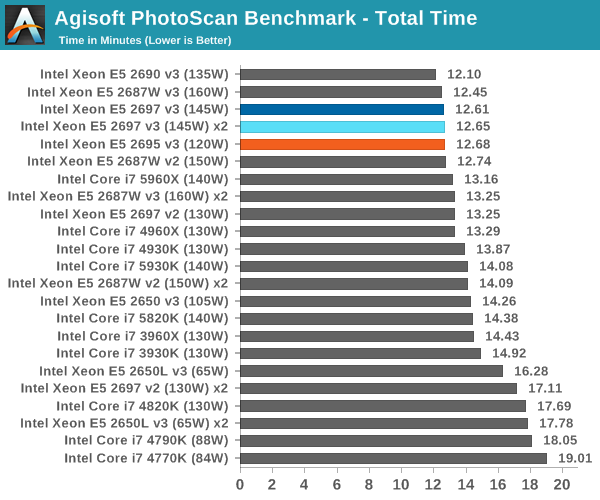
Cinebench R15
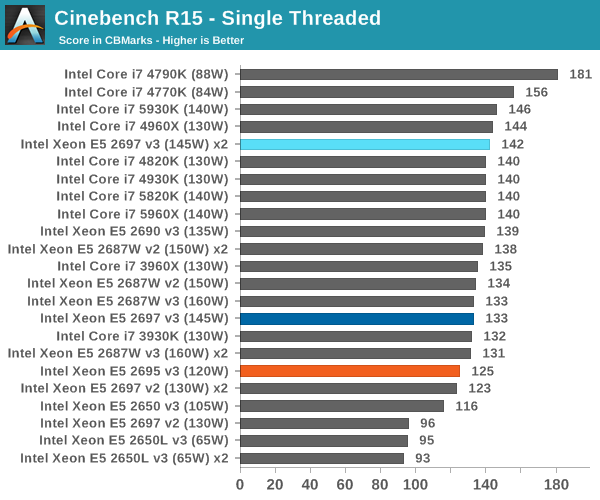
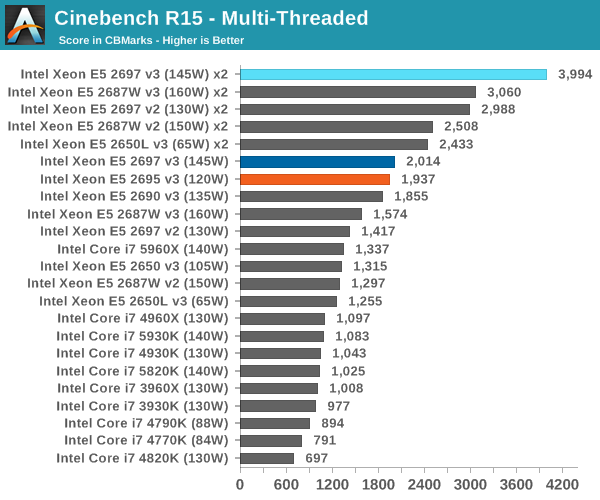
Professional Performance: Linux
Built around several freely available benchmarks for Linux, Linux-Bench is a project spearheaded by Patrick at ServeTheHome to streamline about a dozen of these tests in a single neat package run via a set of three commands using an Ubuntu 14.04 LiveCD. These tests include fluid dynamics used by NASA, ray-tracing, molecular modeling, and a scalable data structure server for web deployments. We run Linux-Bench and have chosen to report a select few of the tests that rely on CPU and DRAM speed.
C-Ray: link
C-Ray is a simple ray-tracing program that focuses almost exclusively on processor performance rather than DRAM access. The test in Linux-Bench renders a heavy complex scene offering a large scalable scenario.
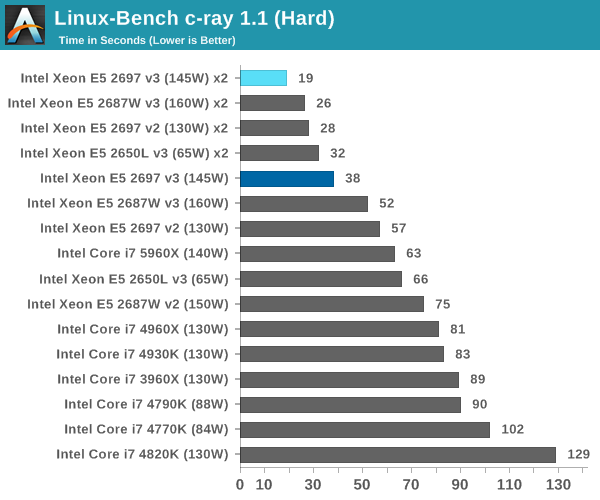
NAMD, Scalable Molecular Dynamics: link
Developed by the Theoretical and Computational Biophysics Group at the University of Illinois at Urbana-Champaign, NAMD is a set of parallel molecular dynamics codes for extreme parallelization up to and beyond 200,000 cores. The reference paper detailing NAMD has over 4000 citations, and our testing runs a small simulation where the calculation steps per unit time is the output vector.
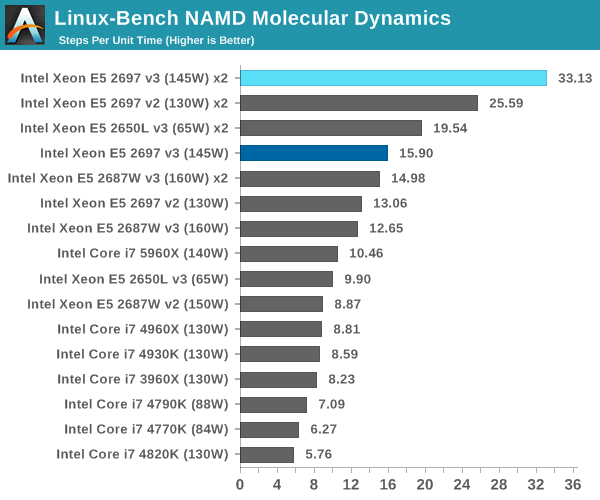
NPB, Fluid Dynamics: link
Aside from LINPACK, there are many other ways to benchmark supercomputers in terms of how effective they are for various types of mathematical processes. The NAS Parallel Benchmarks (NPB) are a set of small programs originally designed for NASA to test their supercomputers in terms of fluid dynamics simulations, useful for airflow reactions and design.
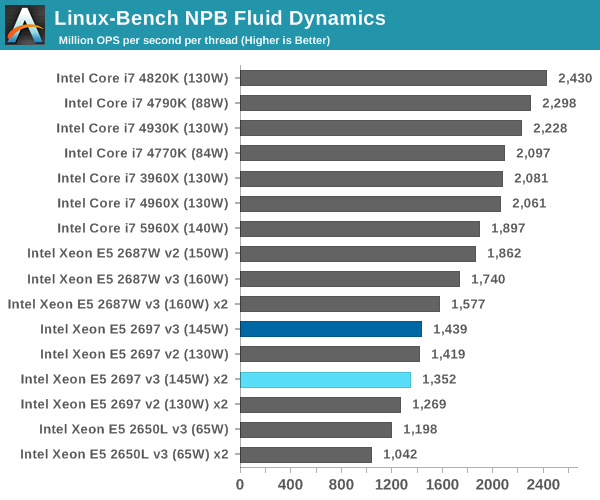
Redis: link
Many of the online applications rely on key-value caches and data structure servers to operate. Redis is an open-source, scalable web technology with a strong developer base, but also relies heavily on memory bandwidth.
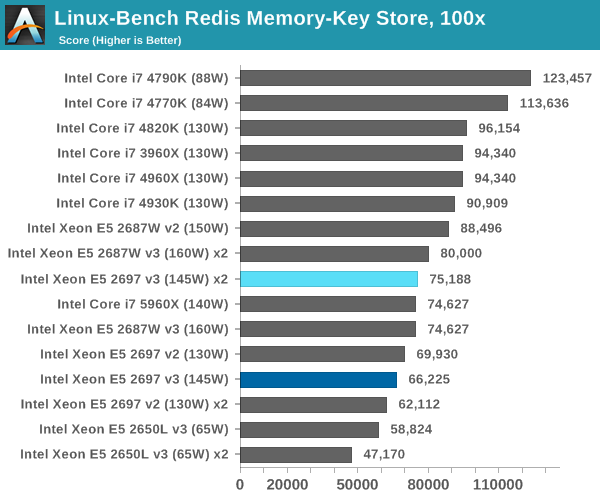
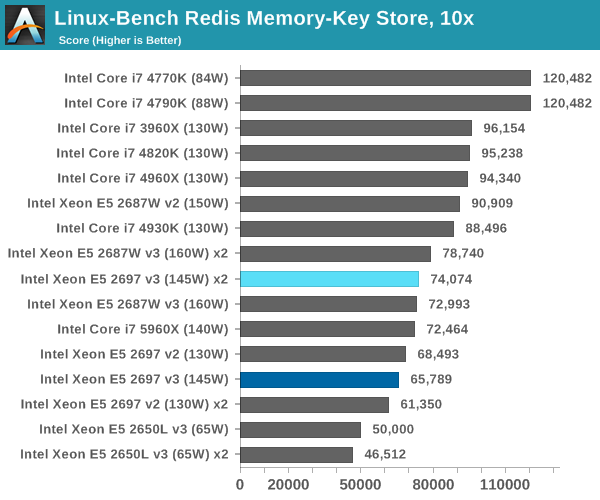
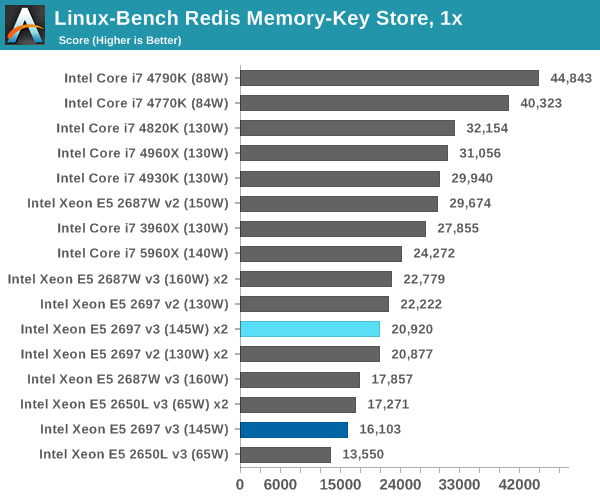










44 Comments
View All Comments
martinpw - Thursday, November 20, 2014 - link
Of interest - Intel did a custom version of the 2698 called the 2698A for Lenovo which pushes the base clock from 2.3 to 2.8GHz. It is water cooled.aka_Warlock - Thursday, November 20, 2014 - link
14 core gaming benchmarks!???!! Wtf?? Who the f*** cares?? Where are the virtualization benches??? Ffs... This is just too god damn poor.wallysb01 - Thursday, November 20, 2014 - link
And I’m pretty sure this has been a main complaint through out this whole E5-2600v3 review, but no action to fix it.SanX - Thursday, November 20, 2014 - link
You take 4790k overclicked to 5GHz and it will win most of single chip benchmarks lolname99 - Thursday, November 20, 2014 - link
"If it happens in a core as part of the logic or caches, that core can be fused off and the die can sold as a lower core part. This is how yields are improved, by reusing the dies that have errors in removable sections."Is this REALLY the case? We've heard this claim for years, but the only case I know of where it's actually been verified is when AMD was selling 3-core CPUs harvested from 4-core dies.
The reason I am dubious is that, if this is such a great system for increasing profits, how come the ONLY place it ever seems to be used is in Intel's server models?
POWER does not sell dies with random numbers of cores. (Or more precisely they talk about 6, 8, 10 and 12 processor variants but, as far as I can tell, each one of these is a separate die. Certainly they have showed the die shots for the 6 processor version.)
ARM does not do this. There are, as far as I know, no ARM phones that save a buck by using three cores harvested from a four core die, even though that would make sense for many markets and many use cases.
Even Intel does not do this outside Xeons. It's the same story as ARM --- given Intel's crazy market segmentation, again there'd certainly be a market for 3-core i7's harvested from 4-core i7's and priced appropriately.
looncraz - Friday, November 21, 2014 - link
From my understanding, some higher models with defects are binned to lower models even if specific dies exist for those lower models.For instance, it could be the case that some i3s are binned i5s, but it would probably be only a few percent of the total number of chips.
chekk - Thursday, November 20, 2014 - link
Power consumption delta is still undesirable. Please Ian, Ryan et al, go back to separate idle and load measurements.kordian - Friday, November 21, 2014 - link
Again, why are there no database scalability benchmarks or virtualization benchmarks? Redis is single-threaded, so of course a high-clocked desktop processor will win - it doesn't take advantage of the main strength of these processors - their huge number of cores. Can we please drop the gaming benchmarks on these and get some benchmarks that reflect the use of a 36 core dual socket box.antialienado - Friday, November 21, 2014 - link
This is an important idea that Anandtech should implement to differentiate itself and add value: Create an Anandtech designation for processors.It could be based on performance, and some common metrics, number of cores, , and many features, but it should be consistent between generations.
Today is easy to get lost. I lost track of many, many meaningless names. Haswell, Ivy Bridge, Sandy Bridge, Vishera, E5-2695 V3 means nothing to me. Too many generations, too many names, conveying too little information.
When I see an article title, saying E5-2697 V3, I don’t get a clue about if this is a portable processor, a desktop, bang for the buck, server, a top processor, review worth of my time, of just a random processor being reviewed just for the sake of making content.
Ok, the title on THIS article says at least that it is a 14 cores Xeon processor, but that is not the point. The point is that ANY article should be clear about what it does review. It does not matter if the title spoils the conclusion by telling the processor performance right on the title. I want information, not a mystery story. The article will explain why it got the designation it got.
There are many dimensions explaining the performance of each processor. Single threaded performance, multi threaded, energy efficient, portable at notebook level, or at tablet/phone level, locked/unlocked, gaming, office, server, workstation, socket compatibility, GPU integrated, etc.
But processor naming make little or no attempt to clarify any of those variables.
I would prefer sockets being referred by year of introduction, features, type of memory, etc; not by another meaningless jungle naming. I already lost track of soo many designations, and each year it gets worse, more varied and confusing.
Anandtech already haves some classifications on GPU and processors based on similar performing. It should be converted into an Anandtech rating, for clarity.
Anandtech should create a naming scheme not making a difference between AMD and Intel when it does not matter (like on performance).
Of course, it would necessarily have unavoidable flaws, but any system would be better that the official naming, and lack of coherency between generations and manufacturer.
Maybe other sites start adopting Anandtech designation.
dave1231 - Friday, November 21, 2014 - link
$0.10 per kwh? Try $0.28 per kWh in the UK then nearly triple the running costs. This is why we are so much better at not global warming.